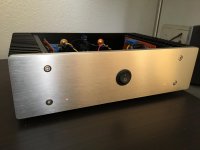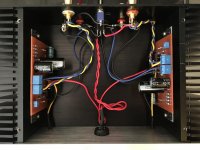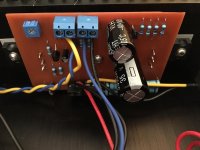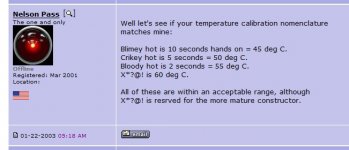As long as there is a set of through the hole daughter cards available, you are absolutely correct. My apologies.
I know I'm correct. I built one already. All of it "through the hole". 🙂
Tidy work skylar - care to share what your final cost was on that piece? Or was it one of those, I can’t remember exactly, or gee, I got kinda speedy on some of the mechanical parts, and ...
Thanks Chrisb
I've stopped keeping track of costs on my projects. It depresses me.
There are no expensive components in that build. The transformer was salvaged from an old Wi-Fi hotspot PSU and the case I've had for years. The most expensive item must have been the PCB's - and it's only $35.
I've stopped keeping track of costs on my projects. It depresses me.
There are no expensive components in that build. The transformer was salvaged from an old Wi-Fi hotspot PSU and the case I've had for years. The most expensive item must have been the PCB's - and it's only $35.
I was planning on building a B1 preamp buffer until several folks said unity gain wasn't the right match for the aca amp. So like several other folks I'm curious as to what bubbles up on this board.
Barry,
A B1 is enough for me in a 10 sq meter room, with ACA 1.2 and low efficiency (85dB) DIY bookshelf speakers, so it will depend on you room and how loud you want to listen.
Barry,
A B1 is enough for me in a 10 sq meter room, with ACA 1.2 and low efficiency (85dB) DIY bookshelf speakers, so it will depend on you room and how loud you want to listen.
rnjorge,
Interesting. This room is bigger but the speakers are also more efficient. It might require setting up a passive attenuator just to test it out to see how the volume works out.
Many thanks.
With regard to the pre-amp question. In the balanced input configuration.
pro level; +6 dBV - (1.99V RMS or 5.65 volts peak to peak) drives my ACA's into sonic bliss. I use an Emotiva Stealth DC-1 and it sounds pretty nice! It appears they stopped making them.
When I built the amps - I used the unbalanced inputs from the same DAC.
Either way, bi-amped into into 92 dB speakers: in a 180 square foot room. A watt is very loud.
pro level; +6 dBV - (1.99V RMS or 5.65 volts peak to peak) drives my ACA's into sonic bliss. I use an Emotiva Stealth DC-1 and it sounds pretty nice! It appears they stopped making them.
When I built the amps - I used the unbalanced inputs from the same DAC.
Either way, bi-amped into into 92 dB speakers: in a 180 square foot room. A watt is very loud.
Finally!
My amp camp amp (homebrew) is playing beautifully, love the sound!
As pointed out by Alan, the semiconductors proved to be cheap chinese counterfeit components, when replaced with parts from trustworthy suppliers all worked like a charm!
One question though, how hot may the case get?🤔🤔
Cheers,
Neel


My amp camp amp (homebrew) is playing beautifully, love the sound!
As pointed out by Alan, the semiconductors proved to be cheap chinese counterfeit components, when replaced with parts from trustworthy suppliers all worked like a charm!
One question though, how hot may the case get?🤔🤔
Cheers,
Neel



Finally!
My amp camp amp (homebrew) is playing beautifully, love the sound!
One question though, how hot may the case get?����
Cheers, Neel
Really pleased you have it working, very well done!
First, they do run hot normally. Can you touch it for a couple of seconds? (Papa Pass scale.)
The other thing I notice is that your chassis is a little bit smaller than the 'kit' chassis. So I guess it will run a bit hotter still.
Alan
PS. 54c is no problem
One question though, how hot may the case get?🤔🤔
The outside of my heat sinks are 136F when the ambient temp is 79F.
Does anyone have a easy way to convert a pcb PDF (just the copper tracks) into gerber files to have the pcb made professionally?
I drew the PCB's in illustrator....
Cheers,
Neel
I drew the PCB's in illustrator....
Cheers,
Neel
That is about 58 C …...should be OK. It is good to keep transistor junction below 100 C even that it can handle much higher temperature. With 58 C on the heatsink you have probably meet this requirement with a good margin.
It is more than the transistors and the heatsinks. The temperature inside the box matters. For example if you check the electrrolytic capacitors' datasheets you will see graphs showing degradation of performance with increasing heat. Some resistors start degrading at 25 C, many do not start degrading until the temperature reaches 70 C. You have to be careful when you purchase parts for a hot environment.
If the heatsinks are reaching 58C, you must have ventilation holes top and bottom to let heat out of the chassis interior. Also I'd suggest feet 25mm tall or taller to ensure you have adequate space under the heatsinks for good airflow. It makes a surprising difference.
Yes, that is true....can see that it is not a standard ACA chassis. As far as I remember my ACA heatsinks reach about 45 C with about 35 Watt dissipation (room temp 23 C).
Free online (EASY EDA ) EasyEDA - Online PCB design & circuit simulator
There’s a lot of tutorials on how to use it on YouTube extremely easy fast cheap good quality
There’s a lot of tutorials on how to use it on YouTube extremely easy fast cheap good quality
You might try pdf2gerb. It's free, which is nice. It's Perl, which may require a bit of setup for you...
Thank you.... I tried, but when I run it with my pdf I get an instant error...
I'll see if they have some sort of support.
- Home
- Amplifiers
- Pass Labs
- Amp Camp Amp - ACA
